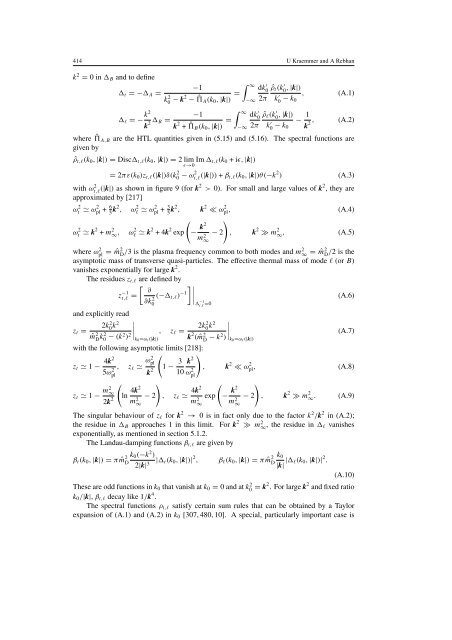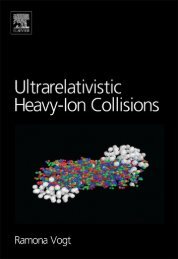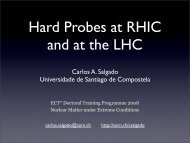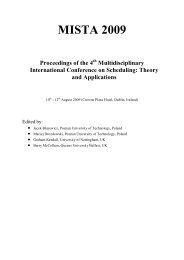Advances in perturbative thermal field theory - Ultra-relativistic ...
Advances in perturbative thermal field theory - Ultra-relativistic ...
Advances in perturbative thermal field theory - Ultra-relativistic ...
You also want an ePaper? Increase the reach of your titles
YUMPU automatically turns print PDFs into web optimized ePapers that Google loves.
414 U Kraemmer and A Rebhan<br />
k 2 = 0<strong>in</strong> B and to def<strong>in</strong>e<br />
∫<br />
−1<br />
∞<br />
t =− A =<br />
k0 2 − k2 − ˆ A (k 0 , |k|) = dk<br />
0<br />
′<br />
−∞ 2π<br />
ˆρ t (k<br />
0 ′ , |k|)<br />
k<br />
0 ′ − k , (A.1)<br />
0<br />
l =− k2<br />
k 2 B =<br />
∫<br />
−1<br />
∞<br />
k 2 + ˆ B (k 0 , |k|) = −∞<br />
dk ′ 0<br />
2π<br />
ˆρ l (k ′ 0 , |k|)<br />
k ′ 0 − k 0<br />
− 1 k 2 ,<br />
(A.2)<br />
where ˆ A,B are the HTL quantities given <strong>in</strong> (5.15) and (5.16). The spectral functions are<br />
given by<br />
ˆρ t,l (k 0 , |k|) = Disc t,l (k 0 , |k|) = 2 lim Im t,l (k 0 +iɛ, |k|)<br />
ɛ→0<br />
= 2πε(k 0 )z t,l (|k|)δ(k0 2 − ω2 t,l (|k|)) + β t,l(k 0 , |k|)θ(−k 2 ) (A.3)<br />
with ωt,l 2 (|k|) as shown <strong>in</strong> figure 9 (for k2 > 0). For small and large values of k 2 , they are<br />
approximated by [217]<br />
ωt 2 ≃ ωpl 2 + 6 5 k2 , ωl 2 ≃ ω2 pl + 3 5 k2 , k 2 ≪ ωpl 2 , (A.4)<br />
( )<br />
ωt 2 ≃ k 2 + m 2 ∞ , ω2 l ≃ k2 +4k 2 exp − k2<br />
− 2 , k 2 ≫ m 2<br />
m 2 ∞ , (A.5)<br />
∞<br />
where ωpl 2 = ˆm 2 D /3 is the plasma frequency common to both modes and m2 ∞ = ˆm2 D /2 is the<br />
asymptotic mass of transverse quasi-particles. The effective <strong>thermal</strong> mass of mode l (or B)<br />
vanishes exponentially for large k 2 .<br />
The residues z t,l are def<strong>in</strong>ed by<br />
[ ] ∣ ∂<br />
∣∣∣<br />
z −1<br />
t,l = ∂k0<br />
2 (− t,l ) −1 (A.6)<br />
−1<br />
t,l =0<br />
and explicitly read<br />
2k 2 ∣<br />
0<br />
z t =<br />
k2 ∣∣∣k0 2k 2 0<br />
ˆm 2 D k2 0 − , z (k2 ) 2 l =<br />
k2<br />
=ω t (|k|) k 2 ( ˆm 2 D − k2 )<br />
∣ (A.7)<br />
k0 =ω l (|k|)<br />
with the follow<strong>in</strong>g asymptotic limits [218]:<br />
( )<br />
z t ≃ 1 − 4k2<br />
5ωpl<br />
2 , z l ≃ ω2 pl<br />
k 2 1 − 3 k 2<br />
10 ωpl<br />
2 , k 2 ≪ ωpl 2 , (A.8)<br />
(<br />
z t ≃ 1 − m2 ∞<br />
2k 2 ln 4k2 − 2<br />
m 2 ∞<br />
)<br />
, z l ≃ 4k2 exp<br />
m 2 ∞<br />
(<br />
− k2<br />
− 2<br />
m 2 ∞<br />
)<br />
, k 2 ≫ m 2 ∞ . (A.9)<br />
The s<strong>in</strong>gular behaviour of z l for k 2 → 0 is <strong>in</strong> fact only due to the factor k 2 /k 2 <strong>in</strong> (A.2);<br />
the residue <strong>in</strong> B approaches 1 <strong>in</strong> this limit. For k 2 ≫ m 2 ∞ , the residue <strong>in</strong> l vanishes<br />
exponentially, as mentioned <strong>in</strong> section 5.1.2.<br />
The Landau-damp<strong>in</strong>g functions β t,l are given by<br />
β t (k 0 , |k|) = π ˆm 2 k 0 (−k 2 )<br />
D |<br />
2|k| 3 t (k 0 , |k|)| 2 , β l (k 0 , |k|) = π ˆm 2 k 0<br />
D<br />
|k| | l(k 0 , |k|)| 2 .<br />
(A.10)<br />
These are odd functions <strong>in</strong> k 0 that vanish at k 0 = 0 and at k0 2 = k2 . For large k 2 and fixed ratio<br />
k 0 /|k|, β t,l decay like 1/k 4 .<br />
The spectral functions ρ t,l satisfy certa<strong>in</strong> sum rules that can be obta<strong>in</strong>ed by a Taylor<br />
expansion of (A.1) and (A.2) <strong>in</strong> k 0 [307, 480, 10]. A special, particularly important case is







